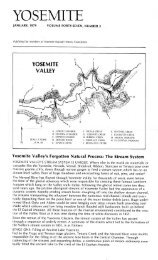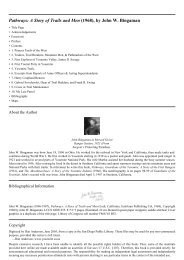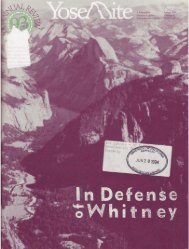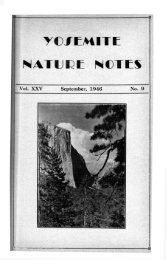Everything Photographic: J. T. Boysen and his ... - Yosemite Online
Everything Photographic: J. T. Boysen and his ... - Yosemite Online
Everything Photographic: J. T. Boysen and his ... - Yosemite Online
You also want an ePaper? Increase the reach of your titles
YUMPU automatically turns print PDFs into web optimized ePapers that Google loves.
the plane records the reflected light . The time it takes forthe light to return indicates the distance from the plane tothe ground, <strong>and</strong> Global Positioning System (GPS) is usedto precisely mark the plane's position from above . LiDARmapping also allows mapmakers to filter vegetation out ofthe final image, providing a high-resolution image of bareground surface.Was the same earthquake thattriggered the El Capitan rock avalanchealso responsible for the park's otherrock avalanches? The answer hasimportant implications for park safety.The El Capitan rock avalanche can be seen clearly inthe <strong>Yosemite</strong> Valley LiDAR map, which has a resolutionof about one foot. The deposit is shaped roughly like ahuge tongue stretching nearly 2,200 feet beyond the baseof El Capitan, about twice the length of the adjacent talusslope . It extends so far onto the Valley floor that it forcesthe Merced River (<strong>and</strong> now also Northside Drive) to takea sharp detour to the south at a site called Devil 's Elbow.The rock deposit is about 1,400 feet wide <strong>and</strong> at least 60feet thick in places . The piled rubble slopes downwardfrom the base of El Capitan to the Valley floor, <strong>and</strong> thenclimbs upward nearly 20 feet toward the leading edge ofthe deposit near El Capitan Meadow . T<strong>his</strong> backslopingmorphology is common in rock avalanches, whichquickly travel outward from the base of the cliff. The ElCapitan rock avalanche deposit includes large angularboulders up to about 2,500 cubic yards in size, weighingabout 5,700 tons . The entire deposit occupies a volume ofabout 3 .75 million cubic yards, or roughly 8 million tons.For perspective, that is equivalent to a cube of graniteabout 155 yards on a side, as long as one <strong>and</strong> one halffootball fields.When did the El Capitan rock avalanche occur? It ' seasy to place a few basic time constraints . We know itmust have occurred after the last glacier retreated from<strong>Yosemite</strong> Valley about 18,000 years ago, but before the" discovery" of <strong>Yosemite</strong> Valley by white people in 1851.But rock avalanche deposits have traditionally provedchallenging to date with st<strong>and</strong>ard geological methods.Most techniques provide ages for the rocks themselves,which works well if your intent is to determine when<strong>Yosemite</strong> 's granites cooled from magma, but isn 't veryhelpful if you want to know when a granite boulder cameto rest at a particular place . However, a relatively newtechnique called cosmogenic exposure dating provides apossible solution . The technique is based on the principlethat cosmic rays from space are constantly bombardingEarth's surface . Exposure to the rays generates certainchemical isotopes in the rock (isotopes are variants ofelements with a different number of neutrons in thenucleus of the atom) . The longer a rock has been exposed,the more of these isotopes it will accumulate . Rock avalanchedeposits are excellent c<strong>and</strong>idates for t<strong>his</strong> type ofdating, for they are composed of rocks that were almostinstanteously exposed during the avalanche . Measuringthe amount of the isotope beryllium-10 in the El Capitanrockfall boulders should indicate roughly how long theserocks have been lying on the floor of <strong>Yosemite</strong> Valley.Earlier t<strong>his</strong> year, we chipped small slabs of rock fromthe tops of five boulders on the El Capitan rock avalanche<strong>and</strong> sent them to a laboratory at Purdue University inIndiana that specializes in cosmogenic exposure dating.Four of the five boulder samples returned ages of between3,400 <strong>and</strong> 3,700 years, strongly suggesting that the ElCapitan Meadow rock avalanche occurred about 3,600years ago . A fifth boulder returned a much greater age ofabout 20,000 years . T<strong>his</strong> last sample likely appears olderbecause we sampled rock that was part of the cliff facebefore the rock avalanche occurred.We now know fairly precisely when the El Capitanrock avalanche occurred . But what triggered it? WereMuir <strong>and</strong> Matthes correct in asserting that an earthquaketriggered the great rock avalanche deposits in <strong>Yosemite</strong>Valley? As it happens, the 3,600-year age for the ElCapitan rock avalanche coincides nicely with estimatesfor a pre-1872 rupture of the Owens Valley fault . JeffreyLee of Central Washington University <strong>and</strong> colleagueshave dug trenches across the fault to study the subsurfacesedimentary layers . Dating the offset sediment layers, theyreported in 2001, allowed them to constrain the pre-1872rupture to between 3,300 <strong>and</strong> 3,800 years ago—right inthe neighborhood of the cosmogenic exposure boulderdates . The dramatic events of March 26, 1872, whichmade such an impact on John Muir, clearly demonstratedthat Owens Valley fault earthquakes are capable of triggeringtremendous rockfalls in <strong>Yosemite</strong> Valley . The mostlogical conclusion is that an earlier earthquake from thesame fault triggered the El Capitan rock avalanche.But one outst<strong>and</strong>ing question about the El Capitanrock avalanche has not yet been answered : Where exactlyon the vast southeast face of El Capitan did the rockavalanche originate? Given that the rockfall dislocatedso much of the rock face, it is surprising that the southeastface lacks an obvious scar. The avalanche materialoriginally could have been a broad slab extending overmuch of the southeast face . However, the vast majorityof rocks in the deposit are composed of Taft Granite,which, according to existing geologic maps, appearsmainly in the summit area of El Capitan . Diorite, a darkcoloredrock that forms the shape of North America onto YOSEMITE ASSOCIATION, FALL 2008




![(March 1982) [PDF] “We Are Pleased to Announce†- Yosemite Online](https://img.yumpu.com/51299748/1/190x242/march-1982-pdf-aeuroewe-are-pleased-to-announceaeur-yosemite-online.jpg?quality=85)
![[PDF] Old Horny, Yosemite's Unicorn Buck - Yosemite Online](https://img.yumpu.com/51269869/1/184x260/pdf-old-horny-yosemites-unicorn-buck-yosemite-online.jpg?quality=85)






![1985 [PDF] - Yosemite](https://img.yumpu.com/48128837/1/184x260/1985-pdf-yosemite.jpg?quality=85)



